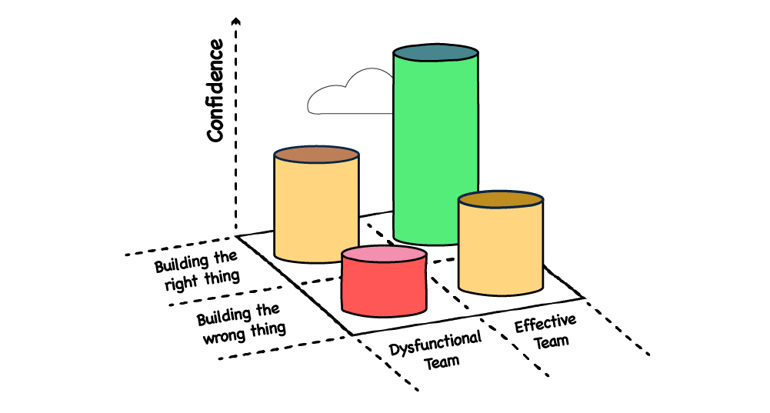People spend a lot of time thinking about building things. Often though they fail to spend time thinking about building companies capable of successfully building those things. More energy is spent worrying about the end product than about how effective the organisation is at building in the first place. There’s a bit of nuance that comes into play in this statement as illustrated below:

What does this mean?
In Melissa Peri’s excellent book “Escaping The Build Trap” she talks about a fictitious company called Marquetly. It’s problem wasn’t that “it did not have a great idea or a great product,” Peri says, but rather “that the company itself was not set up to keep growing that product to succeed. The organisation was missing the roles, strategy, process, and policies needed to really promote and sustain real value creation.”
Peri goes on to state that
“When we lose sight of what is important, when we forget what value means, the products we produce—and sometimes our companies themselves—fail. This has happened to organisations large and small.
Kodak failed to see digital photography disrupting it. Instead of responding to the change, it doubled down on how it always did things. When the company tried to innovate, it was not set up structurally to do so. It was too little, too late.
Microsoft, although not in danger of failing immediately, was on the path to disruption. It had been using the same strategic recipe over and over again, counting on Windows to carry its business, until CEO Satya Nadella came in. He realigned the company to a future strategy that would see it continue innovating and then adjusted the people working on those activities accordingly.”
In short, if your factory or machine is effective, you can confidently count on it to produce consistent results with less need for interference and manipulation, i.e. don’t forget to focus on building a better factory that will build a better product.
At EngineerBetter we feel that there is a perfect opportunity to bring these values and practices to a wider audience. By applying agile and product approaches to client teams, we can in turn help them to become more effective at serving their users.
How it feels: a three-pronged approach
There is a balance to be struck between People, Practice, and Product (Delivery).
Here’s what this looks like for us…
Product delivery
We focus on building momentum through lean experimentation that drives towards significant results. Designing better solutions comes from first making sure you’re addressing the correct and validated problems.
This is done by utilising tried and true practices backed by values we can actually stand behind, while simultaneously keeping an open mind about the fact that there is always room for sustainable improvement.
People
Every organisation is a group of people building things for other people. We believe it makes logical sense to start there when thinking about affecting change in any system. Fostering an open attitude towards learning, and empowering people to have the courage to say when something is not working, helps us to create a more effective factory that is capable of self-correction and growth. In turn we and our team need to be comfortable with being uncomfortable, because that is the nature of growth and change.
Practice
We make time to create strong systems of support, and invest in the infrastructure and processes of an organisation FIRST, followed by conversations around tooling SECOND. Our methods are opinionated, but they are also always open for challenge. Expect that our values will be reflected at the heart of what we do:
- It starts at home… we practice what we preach.. Our goal is to create sustainable ecosystems for the people that work for us and make sure those values are reflected in the way we build things. This in turn allows us to be transparent with our customers and ourselves. Because of this, our organisational ethos functions on the exact same principles and approaches that we promote to our clients.
- Everyone's journey is different and everyone is starting from a different place. Habit changing doesn’t happen overnight. We also acknowledge that it can be challenging to become comfortable with being uncomfortable. Introducing product thinking into spaces where it’s not well-understood, thought about or where there isn’t awareness can be difficult, but we’re here to help.
- It’s ok to walk away if methods don't make sense for you. We believe the best way to move an agenda forward is to be candid and clear about what it will take to progress. We work to ensure we’re always providing value and are forthcoming if we feel we are not. This is why we structure our contracts on time and materials.
A company that embodies a product thinking mindset will be organised around outcomes rather than outputs, with product management seen as an essential function of delivering value to users. As such, company strategy is regularly assessed not only against changing market conditions but also as to whether said outcomes have been successfully met—a pattern that should be repeated in every function in the organisation. Employees are rewarded for learning and achieving goals, and are encouraged to spend time really understanding their customers. For this reason, we encourage you to embed product thinking into the bones of your organisation to ensure that you’re not only building the right things but also building the things right…


 Previous article
Previous article
